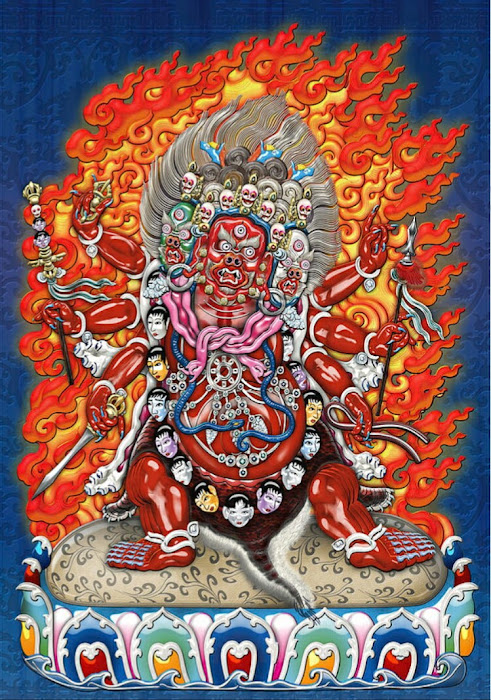Heruka Chakrasamvara and Vajrayogini are emanations of Buddha Shakyamuni
Mountain Gods and Goddesses of Tibet (*Worldly local deities 世俗的神(佛教 ) - of the Himalayan regions are spirits indigenous to a specific geographic region and considered worthy of worship by the local populace. The gods can be considered Bon, Buddhist or regional - equally worshiped by all. The more famous of the gods have been incorporated into religious traditions, losing their local flavour, and worshiped throughout Tibet and the Himalayas. Note* Worldly Protectors, or Deities, is a Buddhist term used to differentiate between Enlightened (Wisdom) Protectors and Worldly (unenlightened) Protectors.
It can be difficult to classify Mountain Gods and Local Deities as to their status as living beings or entities. They are certainly not human and they don't readily fit into the Buddhist description of the Wheel of Life concept coming from the Abhidharma. They are not gods of the Gods Realm, nor are they animals or hell beings. They seem to fit closer to the Ghost Realm, although not exactly hungry ghosts living in a vast empty, dusty, windswept expanse.
Gods and deities are a common feature of Tantric Buddhism. But who are they and where do they come from? Since deities make up a large percentage of the iconography in Tibetan Buddhist painting, sculpture, and more importantly, meditation practice, it is paramount to understand the answers to these questions. Initially the key thing to learn is that the terms “god” and “deity” are used interchangeably with no intended difference in meaning. What exactly are gods and deities? There is probably no easy way to answer this question. The most direct route requires dividing the question into two topics. The first topic is a general broad but inclusive definition of the word “god/deity” (in Tibetan: lha, yi dam) based on a general Tibetan understanding and a conservative dose of Western interpretation.
In Buddhism, a yidam is a manifestation of enlightenment and may take the form of Sambhogakāya Buddhas, tantric deities such as Dakinis, Bodhisattvas, Wisdom Dharma protectors (Dharmapalas) or other historical figures such as past gurus or religious leaders.
The second topic is the enumeration of categories and the many traditional lists and subcategories of deities that are referred to in Indian and Tibetan Buddhist texts and traditions.
The Tantric Buddhist definition for “deities/gods” distinguishes between two very important and different types: worldly gods and beyond-worldly gods. Ordinarily most people refer to all deities as gods and all gods as deities, without distinguishing between worlds and beyond-worldly. In general a god is a supernatural being or presence that lives outside of our normal daily reality and who has the power to interact, for good or for ill, in our personal reality through spiritual connection, ritual, or a cause and effect relationship.
Within Buddhism, these worldly gods are understood as sentient beings who have powers and life circumstances that are different from that of normal humans, but occupy and move through the same wheel of existence—samsara—as humans do, based on the laws of cause and effect.
Examples of worldly gods are Brahma, Indra, Vishnu, and Shiva, along with all of the other less familiar Hindu characters. Included amongst these are the Guardians of the Four Directions, the local gods of the various Buddhist regions of Nepal, Tibet, and Bhutan, which include many mountain and regional gods. To the upper left is an example of the worldly god Brahma, with four faces, orange skin, and riding a large goose.
The enlightened or wisdom beings are believed to be unique to Buddhism and live outside of the wheel of existence. They are considered to be enlightened individuals or emanations of enlightened individuals. They are divided into two further categories: individual entities and emanations. Examples of well-known individual entities that have escaped from samsara are Shakyamuni Buddha, Medicine Buddha, and the meditational deity forms of Manjushri, Avalokiteshvara, Vajrapani and Tara (bottom right).
Emanations originate generally from the five symbolic Buddhas (Vairochana, Amitabha, Akshobhya, Ratnasambhava and Amoghasiddhi) or from the Tantric meditation forms of Manjushri, Avalokiteshvara and Vajrapani.
Examples of emanations are figures such as Hevajra, Chakrasamvara, Vajrayogini, Kalachakra, Mahakala, and many others. The lists and subcategories of deities can be long and sometimes overlap. Next week we will look at some of the more common and well-known categories of Buddhist Tantric deities such as long-life, power, and deities of protection.
Donations for our Buddhist research and development
Do you earnestly cherish our devoted work? Assuming this is the case, we are delighted that you are finding our blog useful and valuable. Would you consider making a donation for our Buddhist research and development?
We need your help to secure the future of scholarly interaction with Buddhism. Since our very first publication of Dharma works and activities in the year 2008, we had been effortlessly providing free distribution of Dharma posts and articles throughout the previous 13 years. We have exceptionally constrained supports and do not receive subsidized or funding from people in general.
Please help us and to develop our Dharma activities that will not only benefit you, but to all Dharma readers on the planet. Please consider showing your support. Your generosity will certainly help us to enhance our work and to accomplish for a better and brighter prospect to come.
Thank you for reading, may you find peace and great bliss. With your support it helps to spread the Buddha’s precious teachings and turning the Dharma wheels in the world.
Aspiration For Bodhichitta
For those in whom the precious Bodhichitta has not arisen
May it arise and not decrease
But increase further and further.
Dedication of Merit
By this merit may we obtain omniscience then.
Having defeated the enemies wrong-doings.
May we liberate migratory from the ocean of existence.
With its stormy waves of birth, old age, sickness and death.
*Note
I do not own or infringe any copyright of the picture(s).
Picture(s) courtesy and credit to the rightful distributors and or studios.
Picture(s) is/are intended for editorial use only.






















